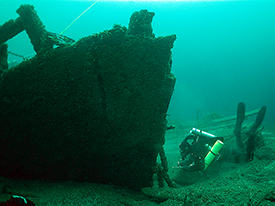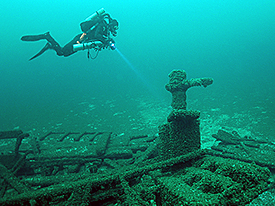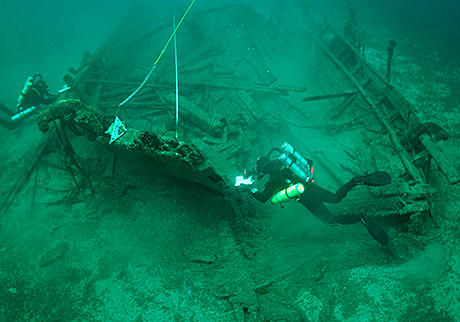
A Fair Wind and a Calm Sea
28 September 2010
By Matt Carter

Exterior view of the Island City's starboard bulwark . Large View (photograph courtesy of Tamara Thomsen).
With many generations of fishing nets removed, the help of four volunteer divers, and the use of closed circuit rebreathers to extend our bottom times on the wreck, it's time to get to work on surveying the Island City. This survey is part of a multi-year Wisconsin Sea Grant Institute grant to study and document this little understood vessel class. The results of the survey will aid in listing the wreck site on the National Register of Historic Places.

Diver recording the keel and deadwood at the base of the collapsed bow. Large View (photograph courtesy of Tamara Thomsen).
On Saturday 12 April 1894 with a fair wind and a calm sea, the Island City cleared Ludington, Michigan, for Milwaukee, Wisconsin, loaded with hard wood lumber. Early the next morning a storm blew up on Lake Michigan and the boat began leaking badly. The crew worked the pumps for nearly three hours but by 11 AM with no hope to keep the vessel afloat, Capt. William Wood, launched the yawl. The yawl immediately became separated from the Island City leaving two crew members aboard who perished with the vessel. Newspaper reports of the sinking and the deposition of Capt. Wood did not give any information on the cause of foundering or the area of failure in the hull. At the time of her loss the Island City and her cargo was valued in total at only $700, likely evidence of the state of disrepair in which the vessel was in at the time of her sinking.

Diver surveying the rudder post and associated wreckage. Large View (photograph courtesy of Tamara Thomsen).
The wreck sits upright but the first 30 feet of port side of the vessel has separated at the bow and fallen outward. In 2009, archaeologists and volunteers from the Wisconsin Historical Society created a photo mosaic of the wreck site and from this mosaic on the wreck site itself we can see the Island City is opened up at the bow. It is difficult to determine if this damage contributed to the sinking of the vessel or if this damage was caused subsequently by years of fishing in the area.
We were able to identify evidence of several repairs and modifications to the vessel. Near the center of the vessel the regular framing gives way to irregular, multiple framing what is believed to be evidence of the lengthening of the ship. Another find during the survey revealed that the deck joint was made up of one large timber upon which the deck beam sat. The lack of knees to support the deck beams is likely evidence of a transition to use in the lumber trade.

Divers examining wreckage and recording the stempost at the bow. Large View (Photograph courtesy of Tamara Thomsen).
Return to MUA Project Journals home page.

